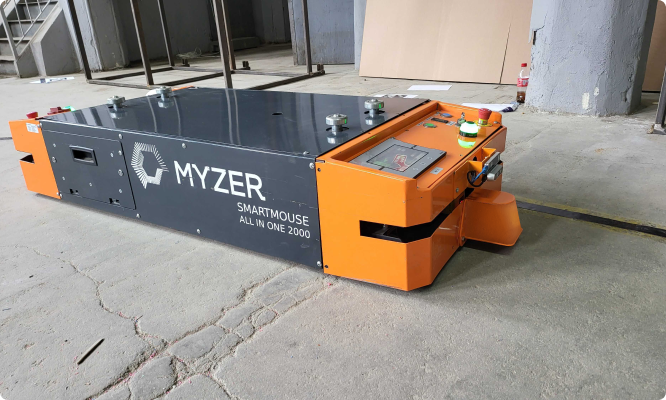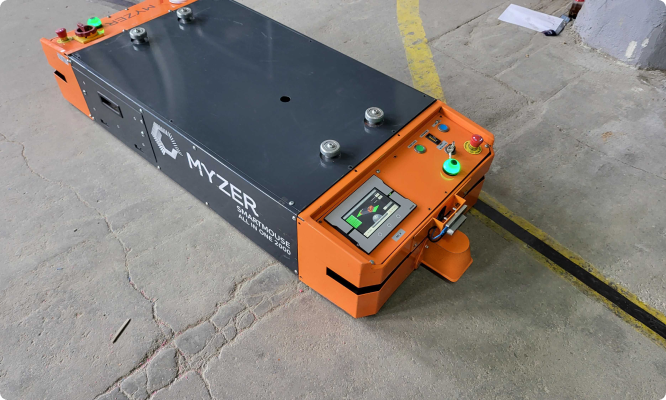High-Tech Software House
(5.0)

At this point, you can't deny it. Robots are everywhere. They clean our houses, produce our clothes, make our cars, and do many other valuable things. They save our lives, give us more work opportunities, and many people's jobs are much more accessible, thanks to their help. Wouldn't it be nice to know how we can use robots in everyday life? Venturing into the unknown can be intimidating, though. Robotics is still a relatively new and constantly developing field of expertise. After all, so you might have a lot of questions about it. Are autonomous robots safe? Will robots take our jobs? How expensive is it to use autonomous robots in your business? How do you even start implementing robotics? Worry not because you're not alone! You have us - Flyps. We are experts in AI and robotics and will guide you through this complex world with pleasure and confidence. After reading this article, you will know what to do next and what challenges await you when deploying autonomous robots. Let's not wait any longer and dive in!

A classical meaning of the word robot is often associated with a successful sci-fi play from the year 1920, called "Rossum's Universal Robots" (RUR) by Karel Čapek, a Czech writer who is famed for his sci-fi works and who is considered to be the creator of the word "robot". The term "robot" generally means a programmable machine capable of carrying out complex actions. Initially, robots were imagined as vaguely human-shaped androids with mechanical bodies and human minds. Their only purpose is to work for humans and make our lives easier. The perception of the world changed drastically in the last few years, as real-life robots began to join us in our jobs and everyday lives more and more commonly. Many of us might not even notice that, but the science fiction idea of machines working alongside humans, aiding them in their needs with superhuman calculating abilities and with their incredible strength not limited by an organic body, is already a reality. Even if the robots we work with aren't humanoid androids and often look more like small remote-controlled cars. What are robots used for nowadays? With technological developments, Automated Guided Vehicles (AGVs) appeared in logistics warehouses, and autonomous vehicles took their place in public transportation. The same basic technical idea that powers the lunar rovers exploring unknown worlds of the cosmos is making your little vacuum cleaner swipe the house for you while providing a convenient mode of transportation for your cat. The horizon of robotics applications is limitless.
Nevertheless, with the autonomy of your robot comes tremendous responsibility and increasing demand for understanding the environment around it so that you are safe and your robot is successful in its tasks.
How to use autonomous robots in your business? In Flyps, we understand the need for the specialization of IT professionals in the future. We introduce the world of autonomous robots to future best specialists and point out the main challenges for those who want to deploy their autonomous robots to the real world. Let us show you what robotics can do for you and the world around you and what you need to overcome to make it a reality.

Autonomous robots are tightly coupled with motion. Current robots can walk, drive, swim, fly, or even do backflips, as best known thanks to the beautiful creations of Boston Dynamics. To do that, they need actuators. An actuator is a device that produces the desired motion based on the energy and signals it's getting from the system. The size of the robot and its mass are vital characteristics that influence the choice of actuators. Large actuators drain the onboard battery faster, forcing the autonomous agent (usually you or another human worker) to charge it more often. Small batteries will let the robot be faster, more agile, and smaller but, simply speaking, weaker.
Additionally, the kinematic structure of your robot affects the steering and the measurement of displacement in the field. The more sophisticated kinematic chain of the robot would demand more complicated motion planning strategies. The first step to deploying autonomous robots is thoroughly understanding what we require of them and what are the physical limitations we'll be facing.
Knowing precisely where and in what conditions our robot will work is crucial for proceeding with its deployment. Sometimes it is not a trivial task to determine how the robot needs to operate in the real world. For example, will it work in a known or unknown environment? This type of question lets you pick a suitable localization algorithm. There are hundreds of algorithms suitable for both situations, and our job at Flyps is to help you pick the right one. If the environment is known, you could just upload the map to the robot and use it to navigate. The robot must create the map in the runtime if it has to work in novel surroundings. Simultaneous Localization and Mapping (SLAM) is the right choice in this case. Choosing the right localization algorithm for our autonomous robot will enable it to move the way we would want it to and do the job we require from it.
Robotics is a vast field with many specializations. Rapid development, especially in the project's initial phase, might be a valuable tactic to see what open-source pieces of software are already available to adapt to your needs. The Robot Operating System (ROS) comes in handy. It's an extensive collection of packages and tools used in robotics for modeling, simulation, navigation, path planning, and more. Additionally, the community focused on ROS is very helpful when you get stuck. There are tens of different ROS versions, each suitable for a different cause and use. So the main question is, what can you use an autonomous robot for? Is it going to be helping in a warehouse? Deliver packages? Or maybe help find survivors in the rubble of collapsed buildings? As is the main rule of robotics, the sky's the limit, so picking the right software is one of the crucial elements of autonomous robot deployment.

What kinds of sensors do autonomous robots use? The sensors of the robot are the core of its perception system. To be more precise, they act as skin, eyes, or ears. This way, we can define how the robot will see the world, how it will operate, and what algorithms will we use in the future. To pick the right sensors, we should answer the question - what kind of senses does our autonomous robot need? Like AGVs working in warehouses, some robots might use Light Detection and Ranging (LiDAR) to localize themselves in a known environment. Whereas autonomous cars driving in cities will use sensors to detect pedestrians and map their surroundings using the same data type. Another type of sensor for an autonomous robot might be simply counting revolutions of wheels to estimate the displacement of a wheeled platform operating on a flat surface. Sensors required for autonomous robots that fly are one of the trickier ones to use. A flying robot probably would need an additional gyroscope and accelerometer to determine its pose in 3D. Remember that some sensors, like Inertial Measurement Units (IMUs), are cheap and affordable. Still, others, especially LiDARs, might also be costly. Thus, choosing the correct sensors might also be strategic from the perspective of the budget. When designing an autonomous robot, consider your budget when picking its sensors.
The development of an autonomous robot is a complex process with many challenges and difficulties. Launching a real-world autonomous robot for the first time is a great day for every engineer working on the project. However, it poses as many happy as potentially dangerous moments. The first time launching an autonomous robot might come with many unpredictable behaviors and results, which can be dangerous for people around it. Nobody wants to live through a comedy cliche of a robot going haywire. Imagine a huge autonomous robot designed to help move heavy packages through a warehouse. Imagine it going crazy and crushing into the storage shelves with all its heavy and rigid frame. Sounds scary, doesn't it? To avoid dangerous situations when deploying an autonomous robot for the first time, prepare a simulation environment before running the actual hardware to prevent such hazardous situations. There are many great open-source simulators for autonomous robots, the most popular being Gazebo, Bullet, and MuJoCo.
Once you have an autonomous mobile robot, fleet management is another challenge on your path to real-world deployment. Fleet management of autonomous robots highly depends on precisely the purpose of the robots. For example, suppose your fleet would operate indoors on predefined paths, such as robots designed to help manage a warehouse. In that case, you should probably focus on planning routes for multiple robots at once to avoid collisions. Moreover, consider adding priorities to agents in the fleet to prevent deadlocks in traffic. On the other hand, robots operating outdoors in a non-defined environment, such as one of the latest Amazon delivery drones, would require stable GPS localization with advanced safety features. As in most other challenges, the most important thing to remember when creating an autonomous robot fleet is its future usage and purpose.
As in other challenges, we have to think about the purpose of the robot first. And isn't the fundamental purpose of an autonomous robot to help us, humans in our everyday work? Taking that into consideration, we need to consider who will be using the robots as well as what they will be used for. Ultimately, the system needs to be simple enough to be available for even non-technical users. Without that, it would be impossible to achieve the desired scalability. Keep it in mind when working on projects where autonomy is involved. Autonomous robots are robots that act on their own accord, based on how they are programmed, without the need for direct control of a human worker. But even with that level of autonomy, our robot fleet will still require a human overseer, who will have to be able to control them and use them properly.

Robotization is a buzzword in the modern industry. It allows to increase the productivity in manufacturing facilities and automate various processes while maintaining a high quality of produced goods and executing tasks. Robots never get tired, nor never complain. They often replace employees with tedious and repetitive tasks, improving their well-being in the workplace. However, real-world deployment is a complicated process with many ambiguities and challenges requiring specialized knowledge. At Flyps, we believe that by delivering our substantive experience, we can bring your robotization ideas to reality.
If you’re further interested in the topic, make sure to use our contact form to send us a message! We love sharing our knowledge and experiences, as well as learning new things. So if you worked on a similar project, tell us about it! Sharing is caring after all, and caring makes the world a better place.
See our tech insights
Like our satisfied customers from many industries